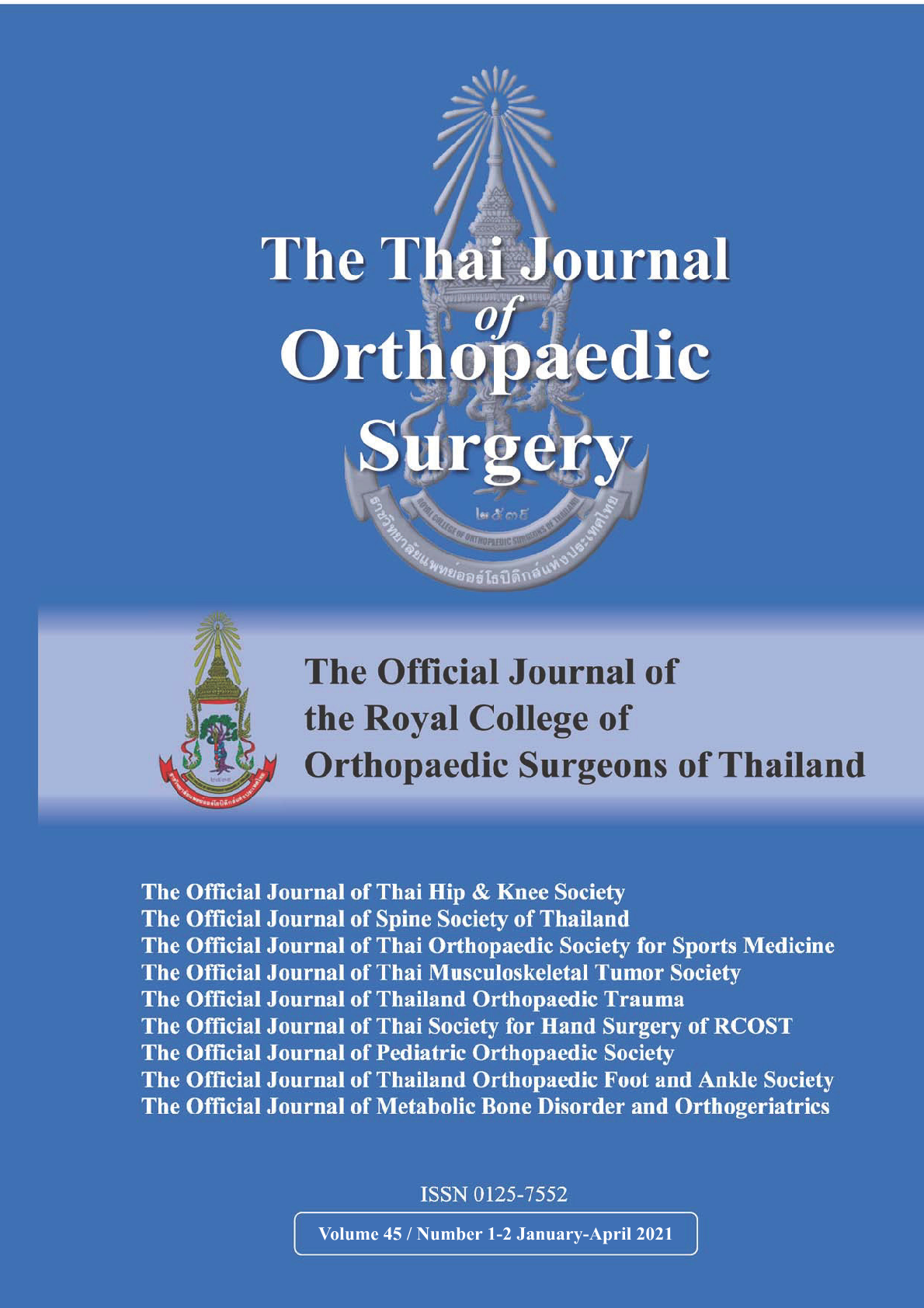Union Time in Minimal Invasive Plate Osteosynthesis Versus Closed Intramedullary Nailing in Closed Distal Tibial Fracture: A Retrospective Study
Main Article Content
Abstract
Background: Distal tibial metaphyseal fracture is the second most common fracture of tibia. Treatment of this fracture is challenging due to the large medullary cavity, covering with subcutaneous, less muscular layer and vascular supply. Closed interlocking intramedullary nailing (IMN) and minimally invasive plate osteosynthesis (MIPO) are two surgical methods widely used to fix this fracture. However, a better union outcome had not been identified.
Objectives: To compare the rate of union within 12 weeks of IMN group versus MIPO group.
Materials and Methods: This is a retrospective cohort study, enrolled the patients with closed distal tibial fracture who were admitted to Orthopaedic ward, Khon Kaen Hospital, from 1 January 2017 to 30 June 2020. The primary outcome was rate of union within 12 weeks.
Results: Of 116 enrolled patients, 63 patients were in MIPO group and 53 were in IMN group. Mean ± SD age was 36.9±16.7 years; 87 were men (75%). The union rate within 12 weeks was 38 of 63 patients (60.3%) in MIPO group and 23 of 53 patients (43.3%) in IMN group, the union rate within 12 weeks was not statistically different in two groups (AOR 1.81; 95%CI 0.78-4.20 p=0.17). The secondary outcomes were not significantly different, except the total operation time (minutes) in MIPO group was significantly higher than IMN group (94.5±18.2 vs 75.3±19.8 p=0.01).
Conclusions: The use of MIPO technique versus IMN technique for treating closed distal tibial fracture was not significantly different in the rate of union within 12 weeks.
Article Details
References
2. Bong MR, Kummer FJ, Koval KJ, Egol KA. Intramedullary nailing of the lower extremity: biomechanics and biology. J Am Acad Orthop Surg. 2007; 15: 97-106.
3. Liu Y-W, Zheng Y-X, Wang X-Z, Zhang H, Sun M-Z, En WX, et al. Case-control study on close reduction combined with minimally invasive percutaneous plate osteosynthesis for the treatment of distal fracture of tibial shaft. Zhongguo Gu Shang. 2015; 28: 230-4.
4. Qi H, Li W, Zhao Y, Zhang Y, Liu Z, Jia J. Comparison study on two operations for treatment of extra-articular distal tibial fracture. Zhongguo Xiu Fu Chong Jian Wai Ke Za Zhi. 2013; 27: 1286-90.
5. Hao BC, Xie KB, Xiong LX, Zhang L, Zhang JS, Zhang J, et al. Manipulative reduction with minimally invasive percutaneous plate osteosynthesis for 60 patients with distal tibiofibular fractures. Zhongguo Gu Shang. 2014; 27: 491-5.
6. Mauffrey C, McGuinness K, Parsons N, Achten J, Costa ML. A randomised pilot trial of “locking plate” fixation versus intramedullary nailing for extra-articular fractures of the distal tibia. J Bone Joint Surg Br. 2012; 94: 704-8.
7. Vallier HA, Cureton BA, Patterson BM. Randomized, prospective comparison of plate versus intramedullary nail fixation for distal tibia shaft fractures. J Orthop Trauma. 2011; 25: 736-41.
8. Väistö O, Toivanen J, Paakkala T, Järvelä T, Kannus P, Järvinen M. Anterior knee pain after intramedullary nailing of a tibial shaft fracture: an ultrasound study of the patellar tendons of 36 patients. J Orthop Trauma. 2005; 19: 311-6.
9. Iqbal HJ, Pidikiti P. Treatment of distal tibia metaphyseal fractures; plating versus intramedullary nailing: a systematic review of recent evidence. Foot Ankle Surg. 2013; 19: 143-7.
10. Robinson CM, McLauchlan GJ, McLean IP, Court-Brown CM. Distal metaphyseal fractures of the tibia with minimal involvement of the ankle. Classification and treatment by locked intramedullary nailing. J Bone Joint Surg Br. 1995; 77: 781-7.
11. Xue X-H, Yan S-G, Cai X-Z, Shi M-M, Lin T. Intramedullary nailing versus plating for extra-articular distal tibial metaphyseal fracture: a systematic review and meta-analysis. Injury. 2014; 45: 667-76.
12. Guo JJ, Tang N, Yang HL, Tang TS. A prospective randomised trial comparing closed intramedullary nailing with percutaneous plating in the treatment of distal metaphyseal fractures of the tibia. J Bone Joint Surg Br. 2010; 92: 984-8.
13. Bedi A, Le TT, Karunakar MA. Surgical treatment of nonarticular distal tibia fractures. J Am Acad Orthop Surg. 2006; 14: 406-16.
14. Vandenbroucke JP, von Elm E, Altman DG, Gøtzsche PC, Mulrow CD, Pocock SJ, et al. STROBE Initiative. Strengthening the reporting of observational studies in epidemiology (STROBE): explanation and elaboration. PLoS Med. 2007; 4: e297.
15. Frederick Azar, James Beaty editors Campbell’s Operative Orthopaedics. 14thed. Elsevier-Health Sciences Division; 2020.
16. Tian R, Zheng F, Zhao W, Zhang Y, Yuan J, Zhang B, et al. Prevalence and influencing factors of nonunion in patients with tibial fracture: systematic review and meta-analysis. J Orthop Surg Res. 2020; 15: 377.
17. Ekegren CL, Edwards ER, de Steiger R, Gabbe BJ. Incidence, costs and predictors of non-union, delayed union and mal-union following long bone fracture. Int J Environ Res Public Health. 2018; 15: 2845.
18. Polat A, Kose O, Canbora K, Yanık S, Guler F. Intramedullary nailing versus minimally invasive plate osteosynthesis for distal extra-articular tibial fractures: a prospective randomized clinical trial. J Orthop Sci. 2015; 20: 695-701.
19. Yao Q, Ni J, Peng L-B, Yu D-X, Yuan X-M. Locked plating with minimally invasive percutaneous plate osteosynthesis versus intramedullary nailing of distal extra-articular tibial fracture: a retrospective study. Zhonghua Yi Xue Za Zhi. 2013; 93: 3748-51.
20. Liu X-K, Xu W-N, Xue Q-Y, Liang Q-W. Intramedullary Nailing Versus Minimally Invasive Plate Osteosynthesis for Distal Tibial Fractures: A Systematic Review and Meta-Analysis. Orthop Surg. 2019; 11: 954-65.

